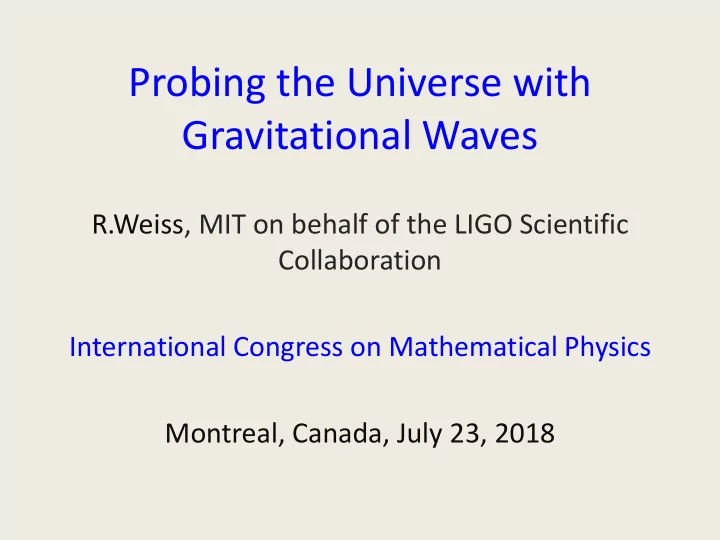

Probing the Universe with Gravitational Waves R.Weiss, MIT on behalf of the LIGO Scientific Collaboration International Congress on Mathematical Physics Montreal, Canada, July 23, 2018
Gravitational waves Einstein 1916 and 1918 – Sources: non-spherically symmetric accelerated masses – Kinematics: • propagate at speed of light • transverse waves , strains in space (tension and compression)
Gravitational waves Einstein 1916 and 1918 – Sources: non-spherically symmetric accelerated masses – Kinematics: • propagate at speed of light • transverse waves , strains in space (tension and compression)
The measurement challenge Kip Thorne
Evolution of the initial detector 2001 - 2006 A clean non-detection
Advanced LIGO design noise budget
After Feb 11, 2016 “Was that you I heard just now, or was it two black holes colliding New Yorker Feb 12,, 2016 Matt Weber
Results of O1 and O2 run announced June 1, 2017 m1=36, m2= 29, Δm =3 if at 1 au h ~10 -6 I g ~ 10 25 w/m 2 m1=23, m2= 13, Δm =1.5 m1=14.2, m2= 7.5, Δm =1 m1=31, m2= 19, Δm =2 masses in source frame
Triple coincidence GW 170814 M 1 = 30 M 2 = 25 ΔM = 2.7 Localization on sky and distance
NGC4493
Origin of the elements
Hubble constant measurement: Galaxy z and distance from GW amplitude
Localization with more detectors
age of universe years hours minutes 1/10 to 1/1000 sec
LIGO Scientific Collaboration
Extra slides
Michelson Interferometer Schematic and GW sidebands
waveforms phasors spectrum phase modulation amplitude MODULATION: Amplitude and Phase
Neutron Star Tidal Distortion high spin low spin tidal distortion
Binary neutron star spectroscopy S.Bose,K.Chakravarti, L.Rezzolla, B.S. Sathyaprakash, K. Takami
E.Oelker, T. Isogai, J.Miller, M.Tse, L.Barsotti,N.Mavalvala,M.Evans
LISA Pathfinder Launched 12/03/2015 At L1, masses released Passed acceleration tests Next, thruster tests
“Solar Mass” Black Holes Credit: LIGO/ Caltech/ Sonoma State (Simonnet)
Recommend
More recommend